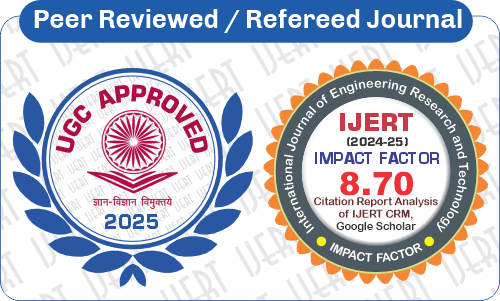 DOI : 10.17577/IJERTV7IS030239
DOI : 10.17577/IJERTV7IS030239
- Open Access

- Total Downloads : 36
- Authors : Habibulla , Prof. Sampatkumar , Dr. C. S Bhaskar Dixit
- Paper ID : IJERTV7IS030239
- Volume & Issue : Volume 07, Issue 03 (March 2018)
- Published (First Online): 28-03-2018
- ISSN (Online) : 2278-0181
- Publisher Name : IJERT
- License:
 This work is licensed under a Creative Commons Attribution 4.0 International License
This work is licensed under a Creative Commons Attribution 4.0 International License
Impact of Particulate Matter released from Construction Activity in Bangalore City A Case Study
Habibulla1,
PhD Scholar,
Jain University, Bengaluru, India.
Prof. SampatKumar2,
Prof & HOD, Department of Civil Engineering,
BMS College of Engineering, Bengaluru, India.
Dr. C.S Bhaskar Dixit3,
Professor,
Centre for Disaster mitigation, Jain University, Bengaluru, India.
Abstract Construction involves construction of building or infrastructure, planning, design and financing. Construction Company plays a vital role in development of country directly or indirectly. It is major source of economy. As it has a major role in development it is having negative impact on human health and environment damaging the natural habitat, vegetation. Emission of fine dust has major cause of mortality and morbidity. Due to rapid urbanization there is huge demand for this activity which in turn cause hazard to environment. The present study is done to estimate the quantity of dust released by construction activity and analyze the impact of particulate matter on human health and environment in Bangalore city. The study concluded that about 14.2 ton/acre/year of dust is generated, and it has a negative impact on the environment.
KeywordsImpact; Particulate Matters; Landuse; Construction
-
INTRODUCTION
Humans have utilized almost half of the non-renewable resources for construction activity making it one of the least feasible industries in the world. Due to increase in population and increase in demand for homes, buildings human beings are utilizing most of the land and converting the natural environment as per their needs and requirement. Urbanization and industrialization leading to deterioration of natural resources which in turn affecting the natural environment and causing imbalance. Construction activities have both positive and negative impact on the environment, as it causes noise, dust, solid and liquid wastes. This activity is considered as the major source of air pollution due to emission of particulate matters causing negative health impact on humans and environment. Due to release of PM2.5 into the atmosphere is the major environmental impact responsible for about 0.8 million premature deaths and 6.4 million years of life lost annually [1]. Emission of these particulate matters may cause impact to the workers working on the site and the neighboring area surrounding the site during construction and demolition activity. Precautionary measures need to take to suppress the dust produced during the process. Particulate matter is present both in solid and liquid phase in the atmospheric environment. This in turn has impact on indoor environment in the neighboring area. There are many sources for the emission of dust and particulate matter like vehicular movement, machineries, roads, etc., [2] [3].
-
OBJECTIVE OF THE STUDY The objectives of the present study are:
-
To analyze the potential impact of particulate matter on human health and environment.
-
To estimate the amount of dust emission from the construction activity.
-
-
MATERIALS AND METHODOLOGY
-
Description of the study area
Bangalore is the capital of Indias Southern State. It is the 3rd most populated city in India with the total population of over 12.3 million people. It represents modern way of developed Indian economy. It is also home for many people who have migrated from other parts of the country. Bangalore is in Southern India (12.970 N & 77.590 E) and is spread over 709 Km2 and about 900 mts above sea level. The city is subdivided into 8 zones with 198 wards under BBMP jurisdiction. It has increases 10 times from 1949 (69 km2) to 741 km2 (2006). Temperature varies from 220 C to 380 C during summers and 140 C 270 C during winters. Bangalore is known as the Garden city of India due to its greenery all around the city but due to rapid urbanization and increased population the vegetation and greenery is vanished. Then city was also known for its lakes, which was paradise of ecosystem. During 1062 there were about 265 water bodies as the urbanization reached peak there was gradual change of water bodies to 98 Numbers [4]. The present study is carried out to estimate the potential impact of construction activities in Bangalore due to rapid urbanization and growing industries. The study is related to impacts on health and environment with construction companies.
Emission of dust from construction operation begins from demolition of building, excavation during which lot of dust is released into the air. Emissions may vary seasonally, and estimation dust can be assumed considering emission factor i.e.
e = 1.2 ton/acre/month
The emission is based on impact of ambient air wind direction since 1970 [5].
-
Land Use Pattern
Analysis of land coverage and land use pattern of Bengaluru city since 1973 to 2012 [6].
Table 1: Land Use Pattern in Bengaluru city
Class
Urban
Vegetation
Water
Others
Year
Ha
%
Ha
%
Ha
%
Ha
%
1973
5448
7.97
46639
68.27
2324
3.4
13903
20.35
1992
18650
27.3
31579
46.22
1790
2.6
16303
23.86
1999
24163
35.37
31272
45.77
1542
2.26
11346
16.61
2006
29535
43.23
19696
28.83
1073
1.57
18017
26.37
2007
30876
45.19
17298
25.32
1005
1.47
19143
28.01
2012
41570
58.33
16569
23.25
665
0.93
12468
17.49
Fig 1: Land use changes since 1973 2006.
Year
Bangalore City
Greater Bangalore
Number of Water Bodies
Area (in Ha)
Number of Water Bodies
Ares (in Ha)
SOI
58
406
207
2342
1973
51
321
159
2003
1992
38
207
147
1582
2002
25
135
107
1083
2007
17
87
93
918
Table 2: Status of Water Bodies
The studies also showed that emission of these fine particles have tremendous impact on environment both in developing and developed countries causing damaged to natural environment, vegetation, water bodies, frest, etc. This is having negative impact on soil reducing its fertility leading to barren land where no cultivation can be carried out. Due to rapid urbanization and increase in construction renewable sources are exhausted. Vehicle movement, vanishes, solvents left behind on site or illegal dumping of waste during rains mix with natural water bodies harming the aquatic lives and increasing the toxicity level.
-
MITIGATION MEASURES
Emission of Particulate Matter can be controlled by following ways [7] [8]:
-
The raw materials used during construction should be stored in demarcated area with proper covering.
-
Proper silos should be provided to store materials.
-
Exhaust system for ventilation for dust suppression should be provided.
-
Use of personal protective equipments reduces impact of construction activity on health.
-
Practice re use of waste on site could be reduce water pollution and make a new method for reuse of polluted water on construction sites.
-
-
-
CONCLUSION
Construction is a never-ending activity which leads to development of any nation. Hence due to this activity there is impact on human health and environment. Even the use of modern technologies the problem of reduction of dust cannot be achieved completely. Certain measures can be adopted to reduce the emission levels. The study done clear picture of how this activity creating impact on human health and surrounding environment in Bangalore City. One can conclude that about
14.2 ton/acre/year of dust is generated from construction activity. In order to control these emissions reuse of waste debris & alternative materials, providing dust suppressors, PPEs, etc. shall be implemented to reduce the risk to health and environment.
-
-
RESULTS AND DISCUSSION
As per the study done we it was studied that the construction operation had adverse impact on both human health and environment. Release of fine dust cause nuisance onsite and off-site activity, dust is emitted through various activities during operation i.e. while loading and unloading of materials. Presence of these fine particles in air there are chances of mortality and morbidity from respiratory disease. These are causing negative impact on health of people in and around the operation site. Because of their size they tend to be hazardous to human health.
REFERENCES
-
Araújo, I.P., Costa, D.B. and de Moraes, R.J., 2014. Identification and characterization of particulate matter concentrations at construction jobsites. Sustainability, 6(11), pp.7666-7688.
-
Basant, S. and Balram, A., 2016. Review on Composition, Emission sources of RSPM, TSPM, Heavy metals and Ions with effect on environment and health. Research Journal of Chemistry and Environment, Vol, 20, p.10.
-
Saxena, D., Kishore, N. and Saxena, P., 2013. Effect of RSPM on Human Health and its Economic Burden (An Empirical Study in City of Taj).
-
Vinay, R.T.B.A., Kulkarni, G. and Nagar, N., 2014. Trees of Bangalore. Environment.
-
Midwest Research Institute, Missouri, Estimating Particulate Matter Emissions from Construction Operation, Sep 30, 1999.
-
T. V Ramachandra, Uttam Kumar, Geoinformatics for urbanization and urban sprawl pattern analysis.
-
Guidelines on Dust Mitigation Measures in Handling Construction Material and C & D waste, Control of Urban Pollution Series, CUPS/89/2017-18.
-
The Impacts of Construction and the Built Environment Page 6 of 6, Document Reference: FM-RE-07 Revision Status: B Effective Date: 21/09/2010.




